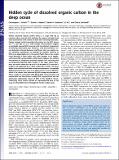Hidden cycle of dissolved organic carbon in the deep ocean
Author(s)
Repeta, Daniel J.; Rothman, Daniel H.; Xu, Li; Santinelli, Chiara; Follett, Christopher L
DownloadFollett-2014-Hidden cycle of diss.pdf (946.4Kb)
PUBLISHER_POLICY
Publisher Policy
Article is made available in accordance with the publisher's policy and may be subject to US copyright law. Please refer to the publisher's site for terms of use.
Terms of use
Metadata
Show full item recordAbstract
Marine dissolved organic carbon (DOC) is a large (660 Pg C) reactive carbon reservoir that mediates the oceanic microbial food web and interacts with climate on both short and long timescales. Carbon isotopic content provides information on the DOC source via δ[superscript 13]C and age via Δ[superscript 14]C. Bulk isotope measurements suggest a microbially sourced DOC reservoir with two distinct components of differing radiocarbon age. However, such measurements cannot determine internal dynamics and fluxes. Here we analyze serial oxidation experiments to quantify the isotopic diversity of DOC at an oligotrophic site in the central Pacific Ocean. Our results show diversity in both stable and radio isotopes at all depths, confirming DOC cycling hidden within bulk analyses. We confirm the presence of isotopically enriched, modern DOC cocycling with an isotopically depleted older fraction in the upper ocean. However, our results show that up to 30% of the deep DOC reservoir is modern and supported by a 1 Pg/y carbon flux, which is 10 times higher than inferred from bulk isotope measurements. Isotopically depleted material turns over at an apparent time scale of 30,000 y, which is far slower than indicated by bulk isotope measurements. These results are consistent with global DOC measurements and explain both the fluctuations in deep DOC concentration and the anomalous radiocarbon values of DOC in the Southern Ocean. Collectively these results provide an unprecedented view of the ways in which DOC moves through the marine carbon cycle.
Date issued
2014-11Department
Massachusetts Institute of Technology. Department of Earth, Atmospheric, and Planetary Sciences; Lorenz Center (Massachusetts Institute of Technology)Journal
Proceedings of the National Academy of Sciences
Publisher
National Academy of Sciences (U.S.)
Citation
Follett, Christopher L., Daniel J. Repeta, Daniel H. Rothman, Li Xu, and Chiara Santinelli. “Hidden Cycle of Dissolved Organic Carbon in the Deep Ocean.” Proceedings of the National Academy of Sciences 111, no. 47 (November 10, 2014): 16706–16711.
Version: Final published version
ISSN
0027-8424
1091-6490